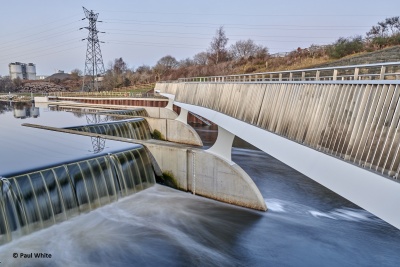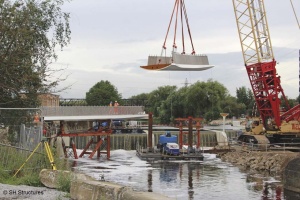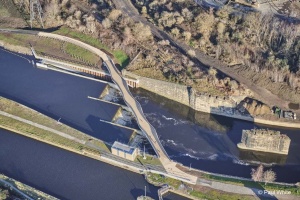Knostrop Weir Foot and Cycle Bridge, Leeds
Structural Steel Design Awards 2018 - Award
The Leeds Flood Alleviation Scheme (FAS) is led by Leeds City Council in partnership with the Environment Agency. It will provide the city centre and over 3,000 homes and 500 businesses with protection against flood events from the River Aire, whilst enabling key regeneration opportunities in the South Bank area. Another objective of the scheme is the provision of new routes for walkers and cyclists, both along and across the River Aire. Knostrop Weir Foot and Cycle Bridge serves to reconnect the much-used Trans Pennine Trail, following the removal of a section of island between the River Aire and the Aire and Calder Navigation for flood risk reduction purposes.
As part of the FAS improvements a replacement weir would be constructed on the Knostrop site, and the client wanted to explore the possible synergy between the new weir and the construction of a bridge across the river. The final design uses the new weir walls as pier foundations for the bridge above, providing significant savings in budget, time and resources.
Leeds City Council recognised the wider value for the design to be of high-quality and identifiable with its place. Despite the apparent complexity of the final design’s appearance, it only requires a single curvature in the fabrication of the steel plate elements. This served to simplify fabrication and enabled the bridge to be delivered within budget and programme. In views along the river the appearance is simple and sympathetic to the natural context. A curved soffit combines with the changing deck width to translate the varying plan width into a rippling deck edge detail, producing a dynamic 'sinuous' quality to mirror the noise and movement of the falling water beneath. Another unique feature of the design is that in elevation the piers are only 50mm thick and almost invisible in long views, creating the illusion of a floating deck. When viewed on closer approach the appearance of the piers changes, emerging as dramatic projecting cantilevers springing from the weir below. Lookout points have been positioned above each pier enabling people on the bridge to stop and enjoy views over the weir and along the river.
Steel was the obvious material of choice to achieve the required aesthetic and minimise the significant construction challenges of working over water. The 70m long bridge was fabricated in S H Structures’ facility, which is situated just 17 miles from the Knostrop site, and treated at a local facility, minimising the environmental impact of the works.
Construction over a river creates special challenges in order not to harm the waterway and its ecology. Minimising the time and extent of temporary works in the river was an essential aspect of the design. The prefabricated superstructure sections and piers were installed over two weeks using a crane. At the abutments special eel bypasses have been incorporated to allow for migration, whilst a dedicated fish bypass is included in the weir.
Given the accuracy required to successfully realise the complex steelwork geometry and installation, it was decided to embrace Building Information Modelling (BIM) from the outset. The Revit model of the bridge enabled every element to be accurately represented and positioned; including every steel plate in the bridge’s curving geometry and all connection elements. This was particularly valuable when designing the highly complex bolted integral pier connection. During fabrication the BIM model was also utilised to allow every component to be spatially positioned and checked. The model was also used to assist in the design of the workshop temporary works as the complete length was fully assembled, allowing the critical interfaces to be set, checked and maintained during the fabrication process.
In a wet environment over a weir, careful detailing, specification and construction are essential to ensure a long-lasting and durable solution for a bridge. The bridge superstructure is predominantly constructed using weathering steel with a four-coat paint system normally only used for difficult access highway structures. A primary concern was for the durability of the bolted connections between assembled elements of the bridge. This required highly protective details and connections that far exceeded what was needed for structural requirements to minimise water ingress.
One of the key features of this elegant structure is the slim piers. To achieve the required aesthetic and structural performance this area required careful consideration. Once the concrete weir walls had been poured and the holding down bolts installed, a detailed as-built survey was carried out. The recess bolt holes in the curved pier base plates were drilled and machined to match the as-built layout of each bolt group. With this work done, each base plate was trial-fitted to check for fit before the piers were finally installed, surveyed and cast in place. This attention to detail is critical to the successful installation of this type of precision detailing.
| Architect | Knight Architects |
| Structural Engineer | Mott MacDonald |
| Steelwork Contractor | S H Structures Ltd |
| Main Contractor | BAM Nuttall |
| Client | Leeds City Council and Environment Agency |
Judges' comment
This team solved an unusual bridge alignment by producing a thoroughly modern intervention in a post-industrial landscape whose unique qualities are derived from the constraints of the flood relief requirements. Using ingenious geometry and thorough attention to detail, the prefabricated sealed modular deck units appear to float on impossibly slender vertical supports. The result is an economic, robust and graceful solution. The overall rippling effect of the bridge is intriguing, yet it is rooted in logic; a seamless integration of architecture and engineering.






